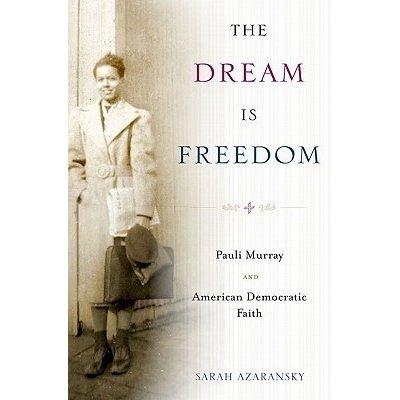Earlier this academic year, Pittsburgh Theological Seminary’s American Religious Biography class studied biographical accounts of seven women and men whose lives spanned the centuries from the colonial era through the 20th century. After digging deeply into the historical accounts of those Christian figures, students reflected on what insight each narrative might have for modern Christians, asking What we can learn from the past to inform modern lives of faith? The blog below is the second in a four-part series of reflections by students in this course taught by the Rev. Dr. Heather Vacek. Read the first reflection—Redeemer: The Life of Jimmy Carter.
How do Christians affirm and encourage the dignity and humanity of someone they do not understand or agree with? In diverse and divisive times, what happens when we do not want to recognize the humanity of others, because their self-identity threatens ours?
Sarah Azaransky’s The Dream Is Freedom: Pauli Murray and American Democratic Faith described the mid-20th century lawyer, activist, and priest who undertook the quest of understanding the entanglement of American race relations rightly, in order to show that the races were responsible for reconciliation with each other. Pauli Murray’s “democratic eschatology” confronted the democracy promised by America as “partially present,” yet faithfully anticipated it as “yet to come” (5). Instead of shying away from the meaning of race, or manipulating the finer distinctions that sexuality, gender, and politics bring to the discussion, Murray tried to come to terms with them, asserting that “meaning is produced at the intersection of identities” (117). Azaransky depicted Pauli Murray as a “primary democratic subject” and not just as a problem to be solved (69).
Chapter 1 showed how Murray wrote the poems Color Trouble and Mulatto’s Dilemma as she came to terms with her racial, gender, and sexual identity that contradicted secular definitions. Murray initially insisted on recognizing these contradictions not as things to be glossed over, and she grew to call them “precursors to reconciliation” (118).
Chapter 2 showed how Murray wrote Proud Shoes to interpret her multiracial family experience not as a problem in American history, but as its true expression. Murray used the narrative of Abraham sending Hagar and Ishmael into the desert to characterize the experience of African-American women “standing utterly alone, in the midst of serious trouble, with only God’s support to rely on” (49). She labeled the entangled American story as “Ishmaelite,” especially as she struggled with her grandmother’s deep respect for the family’s slave-holders. Murray concluded, “I had to embrace all the tangled roots from which I had sprung, and to accept without evasion my own slave heritage, with all its ambivalences and paradoxes” (47). In Dark Testament, Murray confronted the “official” narrative of the inclusive, assimilative America with the wearying, but accurate counter-narrative of exclusion and individual experience. Azaransky wrote, “Murray argues that history will always exceed the telling; this means that the particular narrative we have chosen as normative at any particular moment has important democratic implications” (50). When “the other’s” experience threatens the accuracy of the official story, Pauli Murray challenges us to not to reject that distinction as insignificant.
Chapter 3 showed how Murray’s biblically-informed vision rendered American’s democratic promises in a “process of becoming,” rather than actual reality (71). Murray stood outside of the prevailing narratives of race relations of her time, and made Americans responsible for fulfilling racial reconciliation. Her eschatology challenged white institutions committed to the official narrative (73). Her vision also challenged black power and feminist movements committed to counter-narratives (31). When Murray tried to relocate to Ghana, she found that her belief challenged African skepticism toward American democracy (53). In these ways, Pauli Murray uniquely inserted herself into history, as she used biblical narratives to evaluate established definitions of race, gender, and politics.
The last chapters described Pauli Murray as the first African-American female Episcopalian priest. She reminded her congregation that the oppressed, forgotten, and discarded are actually crucial to the Christian story. In her sermon, Mary Has Chosen the Best Part, she interprets the different responses of Mary and Martha to Jesus in Lk 10:38-42. Murray said, “we can see Mary as an unusual woman, one who was unwilling to accept the role defined for her and was drawn to Jesus of Nazareth, because he treated her like a person with an intellect and a quest of knowledge for God” (103). Pauli Murray provides us with a Christian reminder to not just see “the other,” as a problem to be solved. Instead, she taught us that we can recognize their humanity in their counter-narrative, do our best to heal the hurts caused by their historic exclusion, and keep the path to Christ open, when someone else closed the door on their identity.
All Citations taken from: Azaransky, Sarah. The Dream Is Freedom: Pauli Murray and American Democratic Faith. New York: Oxford University Press, 2011.
The full reading list for the Fall 2015 American Religious Biography course included: Catherine Brekus, Sarah Osborn’s World: The Rise of Evangelical Christianity in Early America (2013), John Wigger, American Saint: Francis Asbury and the Methodists (2009), Jon Sensbach, Rebecca’s Revival: Creating Black Christianity in the Atlantic World (2005), Richard S. Newman, Freedom’s Prophet: Bishop Richard Allen, the AME Church, and the Black Founding Fathers (2008), Matthew Avery Sutton, Aimee Semple McPherson and the Resurrection of Christian America (2007), Sarah Azaransky, The Dream is Freedom: Pauli Murray and Democratic American Faith (2011), Randall Balmer, Redeemer: The Life of Jimmy Carter (2014). In addition, readers interested in the role of history in the life of faith might enjoy: Margaret Bendroth, The Spiritual Practice of Remembering (2013).
Gregory Jones Jr. is a junior master of arts student at Pittsburgh Theological Seminary.

